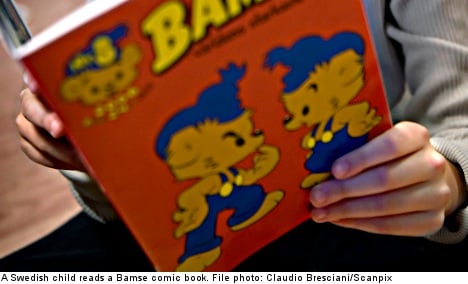Swedish writer Rune Andréasson invented Bamse in 1966, but the little bear got his own series of comic books a few years later, in January 1973. Publishers Egmont are therefore celebrating Bamse’s 40th birthday this year, starting with the first issue of 2013, which was released on Tuesday.
”It’s marvellous that the comic book is read every week by 100,000 children 40 years later,” Bamse editor-in-chief Charlotta Borelius said in a statement.
Bamse is the world’s strongest bear, but only when he eats his grandma’s special honey, a bit like French comic book hero Asterix and his druid potion.
SEE A GALLERY OF BAMSE: THE WORLD’S STRONGEST, AND KINDEST, BEAR
The kind bear, who wears a little blue hat that looks suspiciously similar to a night cap, is constantly out and about on various adventures, when not raising his family of four – triplets and their baby sister – with his wife Brummelisa.
The triplets are non-identical and as different as different can be. Brum is a boys-will-be-boys kind of cub, while Teddy, who is near-sighted and wears glasses, steps in as the classic nerd.
Their sister, Nalle-Maja, is a bit of tough cookie, who in one story punches a schoolyard bully on the nose.
Kid sister Brumma battles with developmental issues when she is young and is later diagnosed with autism.
Bamse’s posse of friends is as intriguing as his family.
Creator Andréasson believed it was courageous to be honest about being scared. If that motto had a poster child, it would be the ever-nervous rabbit Lille Skutt (‘Little Hop’), one of Bamse’s trusted friends.
More often than not, however, despite the comic book pages almost vibrating with Lille Skutt’s anxiety, the white bunny will give his all for his friends. He’s married to a journalist and has one son.
LISTEN TO A RENDITION OF THE BAMSE THEME SONG
The second of Bamse’s two wingmen is the lanky turtle Skalman (‘Shell Man’), who unsurprisingly is a mentor and idol to Bamse’s studious son Teddy. And Skalman can build any device and solve any problem.
Yet Skalman’s dogmatic dedication to a healthy lifestyle routine often endangers the trio’s undertakings. Come hell or high water, if his antique alarm clock goes off, he will either tuck into a snack or fall right to sleep.
The colourful gallery of characters often engages with hot-button topics.
Andréasson never shied away from difficult topics, including racism, gender equality and addiction.
“You have to be nice to people who do bad things, because they need it the most, and it might make them kinder,” reads one of the mottos in the comic book.
It is widely accepted that Bamse originally stood for left-of-centre views on society and politics, although the youth wing of the conservative Moderate Party once went as far as dubbing him a communist.
A celebratory description of Mao Zedong in an issue of Bamse published in 1983 raised more than a few hackles:
“The country was liberated from war lords, businessmen and foreigners who used to be in charge. Before the liberation, many millions of people starved to death. After 1949, food is shared equally and nobody starves,” one issue read.
Bamse fails to mention the several tens of millions of people who died in the Chinese famines.
The last time Bamse made headlines was in 2011, following a special edition produced for the Swedish Migration Board (Migrationsverket) to help explain the asylum process to young children.
The special issue featured a rabbit family allowed to stay while a badger family has their asylum application turned down.
As the badgers are sent home, happy relatives wait to welcome them as their aircraft touches down.
The story outraged several commentators who thought it played down the complexity of deporting children and the potentially real threat of persecutions and abuse upon return.
In response to the backlash, Bamse’s publishers said they acknowledged the complexities surrounding asylum cases involving children, but instead said the comic had been meant to ease their anxiety.
“In some cases, the scenario in the comic book could be true, in others it would be significantly more difficult for returning children. But we didn’t want a traumatic ending to the story, but instead to give the children hope,” Ola Andréasson told Skånska Dagbladet at the time.
Since Andréasson’s death in 1999, many observers, not all of them happy, have noted that the comic books have become more mainstream.
Not least because Bamse over the years has found his way into endless commercial tie-ups, with his furry face adorning everything from toothpaste tubes to bed linen.
Had Bamse become a turn-coat capitalist? Or, at least, had his publisher?
In an opinion piece in 2003, entitled ”Bamse is no longer the leftie bear,” Dagens Nyheter (DN) reporter Mats J. Larsson wrote:
“The three-decade transformation of Sweden from a successful welfare state to a society that has adopted many of Margaret Thatcher’s market liberal ideas, albeit in light versions, has also rubbed off on the stories about the super-duper strong bear.”
Take a look at our past Swedes of the Week.
Ann Törnkvist



 Please whitelist us to continue reading.
Please whitelist us to continue reading.
Member comments